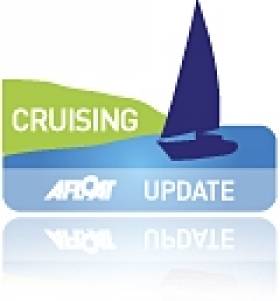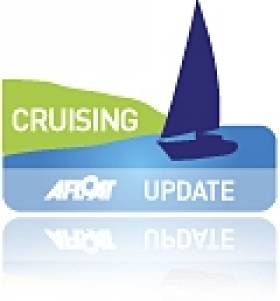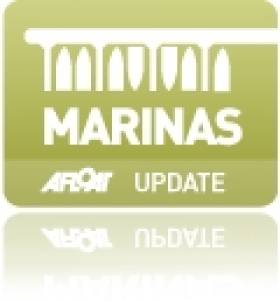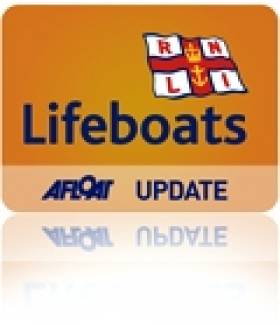Displaying items by tag: Cruising
Schengen Area Cruiser's Survey Needs Input, Say OCC
Ocean Cruising Club (OCC) Member Kingsley Ross has created a survey to help quantify the economic impact on cruising areas caused by restrictions on visa terms for cruisers from outside the Schengen agreement area who visit by yacht. The OCC urge cruisers who have any experience with this matter to please take a few moments to supply input to this important survey. The survey is online here
The information will be collated and analysed to support a case for easing visa restrictions on visiting yachtsmen by the EU and Schengen countries. Legislation to establish a touring visa has already been proposed but not acted upon. It is hoped that providing tangible figures on economic impact can help move the new proposed European legislation forward.
"This survey will capture information on how much is being spent in non-Schengen countries while cruisers were staying in them to avoid violating Schengen visa restrictions. While I think the survey will help, going to your own representative is a crucial way of making this happen. The survey results hopefully will give some ammunition to this type of effort," explains Kingsley Ross, lead coordinator.
OCC Rear Commodore Peter Paternotte is contacting the Netherlands Automobile Association, a truly Europe-focused organization also looking after the interests of "land cruisers" from abroad who face similar issues. He adds, "I have been concentrating on raising the awareness of the concerns of those travelling by sea with the European Boating Association and will also contact Dutch EU Parliament members. The more support we can muster the better."
"The Corsica anchoring tax adds another dimension as it is relevant to European flagged cruisers as well. This survey can be a valuable tool for future interventions. Besides using the data to argue the Schengen issue and the new fees in various countries, it could be used to support cruiser friendly policies in Turkey, Great Britain and elsewhere," added OCC member Gus Wilson, collaborator on this effort in the UK.
#coolroutes – Cork Institute of Technology (CIT) is very strongly extending its research and development into a wide range of European regions. The institute has just been awarded a significant project to develop a new maritime tourism route between Cork and Arctic Circle areas of Norway. The objective is to establish a yacht cruising route extending from Cork in Ireland via Northern Ireland and Scotland to the Faroe Islands and Norway. The route, once operational is envisaged to create a wide range of local economic opportunities in very beautiful and peripheral locations.
The Northern Peripheral and Arctic Interreg VB Programme (NPA) funds transnational projects addressing transnational innovation, enterprise development and entrepreneurship across the programme territories covering Southern and Western Ireland, Northern Ireland, Western and Northern Scotland, the Faroe Islands, Western Norway, Iceland and Greenland.
CIT has now received funding for a project valued at €1.26 million to develop a coordinated yacht cruising route, stretching around the coastline of the NPA. The project entitled "Cruising Oceans on Latitudes above 51 º North " - The " COOL Route", was recently approved by the NPA Interreg Programme and will research all of the logistical, business and marketing planning for the route, which will support other complimentary maritime and shore based tourism initiatives in all of the intervening regions along the route.
Partners and responsibilities in the COOL Route Project are Cork Institute of Technology (Lead partner and Business Planning),Donegal County Council (Project Publicity and Dissemination), Glasgow Caledonian University (Route Logistics and Planning),Royal Cork Yacht Club (COOL Route Marketing), Derry City Council (Common Booking System), Torshavn Port Authority ( Expert inputs safety ) Blues Seas Marinas ( Expert inputs design, realisation and commercialisation planning), Western Norway Research Institute ( Rural Tourism Development). Associate partners and other project informal participants include the Irish Cruising Club, Donegal Tourism, Sail Scotland and the Irish Sailing Association along with a wide range of Local Authority, Local Development, Tourism and Sailing interests.
The Cool Route Coastline is one of the most scenic cruising grounds globally and apart from the outstanding natural beauty of the route, it provides uncrowded and most importantly highly secure waters in which to voyage over long distances.
The Cool Route Project which has its inaugural Steering Committee in Cork Institute of Technology on 14th April plans to develop wide ranging dialogue and close engagements with all service providers, tourism interests and other interested stakeholders.
Sailing's Secret Side Revealed in Irish Cruising Club Awards
#irishcruisingawards – As the recent Irish Sailing Association's Public Consultation meetings in Dun Laoghaire, Cork and Galway to discuss its new Strategic Plan 2015-2020 have shown, the cruising community may not be high profile, but there are many of them, and their behavioural patterns in going afloat, and ways and means of doing it, are as varied as their extraordinary range of boats.
What is clearly emerging is that the cruising people expect Irish sailing's national authority to be able to guide them towards qualifying for the International Certificate of Competence, it also expects them to be able to negotiate the government into a more sensible and manageable system of boat registration, and it expects the ISA to be up to speed on the problems being faced about the lack of convenient fuel pumps for marine diesel, and the continuing confusion in the situation regarding which type of fuel is legally available for use on boats.
But while those who cruise expect the ISA to provide a user-friendly administrative environment in which they can go about their various projects and pleasures afloat provided that they comply with statutory safety regulations, they do not seem to wish the ISA to be organisationally involved with what they actually do afloat. W M Nixon takes up the story.
Racing, with its global structure of competition, its many internationally-recognised rules and regulations, and its basic requirements of competence by event management teams, is an obvious area of interest for the Irish Sailing Association through supportive action and, where required, direct involvement.
But cruising......well, for the racing obsessives who garner the bulk of sailing's attention and publicity despite probably being the minority of those who go afloat, cruising is usually seen simply as "not racing". It is essentially a private venture usually involving just one boat and her crew. And even where experienced crews have committed themselves to taking part in a more formalized Cruise-in-Company run by some group or club, they expect significant segments of down-time where each boat or small groups of buddy boats can go off and do their own sweet thing in terms of itinerary and length of passage chosen.
But for most cruising crews, the ideal cruise is carefully planned for just one boat, taking into account the time available and the capabilities of boat and crew, and making due allowance for the conditions prevailing in the cruising ground selected, while always realizing that the final word on what is or is not achieved will be ultimately dictated by the weather.
On such cruises, while some arrangements may be made ahead, with crew changing at pre-ordained ports often a dominant factor, the underlying hope is that there will be a sense of freedom of movement as to specific ports and anchorages being visited. And far from expecting to cruise in a formalized group, the traditional cruising enthusiast will reckon that new friends met informally ashore or on other boats in newly-visited anchorages and harbours is all an essential part of the colourful mix of unplanned yet enjoyable experiences which makes up a good cruise for just one boat voyaging on her own.
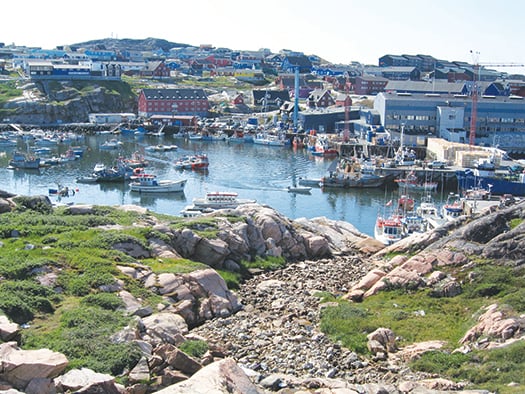
Objective achieved. Eddie Nicholson's Najad 440 Mollihawk's Shadow from Kinsale in the midst of things in the far northern harbour of Illulissat in West Greenland. This was the cruise which has been awarded the ICC's Strangford Cup. Photo: Pat Dorgan
Then too, every so often the boat and her crew will have to deal with adverse weather conditions. Doing so successfully and competently is part of a truly satisfying cruise. And so is reaching some objective, whether it be a distant port or island, or some place which provides access to a desirable mountain top to meet the needs of those climbers who are drawn to the possibilities offered by a cruising boat's wide range of destination options.
And then there are the cherished memories which only cruising can provide, while equally there are shoreside experiences which seem heightened when you've come off a boat to witness them. For instance, the famous swing of the mighty incense-filled Botafumeiro in the ancient cathedral at Santiago de Compostela in Galicia in northwest Spain is something wonderful to behold at any time, but when you happen upon it by lucky chance the day after you've sailed your boat out to Spain from Ireland, it becomes almost supernatural.
As for experiences which are exclusive to cruising folk, you can only really sail in to Venice with the dawn on a cruising boat, the only way to see Bonifacio as Ulysses saw it is when cruising, only with a cruising boat can you coast along under the absurdly vertical and ridiculously high Fuglabjorgs – the bird cliffs – of the Faeroes, only when you've got there with a cruising boat can you really savour the unique sense of place at Village Bay in St Kilda, and only by arriving in a lone cruising boat can you grasp just what a very special place is to be found at Inishbofin.
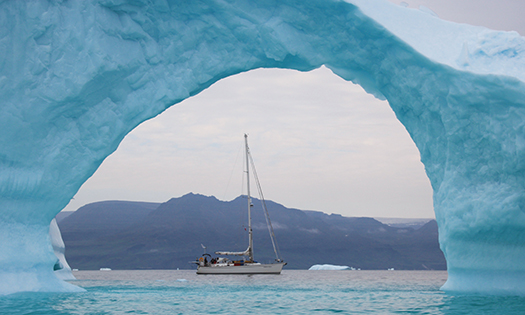
So who needs a picture frame? Mollihawk's Shadow in a classic Greenland setting. Photo Pat Dorgan
While the unique pleasures of cruising are available to anyone with the basic experience and ability combined with access to an appropriate boat whether owned or chartered, in the final analysis these are private pleasure, intensely personal in their meaning. And thus they're just about unmeasurable by any known system. So how on earth can any national authority which is inevitably training and racing oriented get a handle on what is going on in the world of Irish cruising?
Well, you could try just counting the number of boats with a lid in each port which don't go racing, and simply conclude that they should be added to statistics as part of the Irish cruising fleet. You could go into more detail by research through questionnaires to marina berth or mooring holders. And you could extrapolate answers which might give some sort of statistical picture. But as the recent Sports Council report on the numbers supposedly taking part in all areas of watersports involving floating vehicles of some sort or other and based on figures supplied by each special interest organization might suggest, you could well end up with some rather fanciful totals.
Thus last night's Annual General Meeting in Dun Laoghaire of the Irish Cruising Club was more than just a get-together of the organisation which has been at the heart of Irish cruising from its formation in 1929. For the ICC AGM is when Irish cruising is most closely analyzing itself. Since its formation, the club has become firmly established in its central role through publishing its unrivalled sailing directions for the entire coast of Ireland in two regularly up-dated volumes based on unrivalled local knowledge.
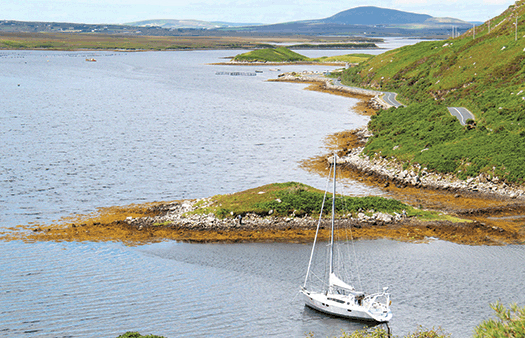
Man at work. ICC Sailing Directions Hon. Editor Norman Kean has placed Niall Quinn's new Ovni 395 Aircin in a decidedly neat little spot in Bellacragher Bay on the mainland side of Achill Sound during a research of the neighbourhood. For his tireless efforts on behalf of pilotage research, Norman Kean has been awarded the Rockabil Trophy for 2014. Photo: Norman Kean
But while the Sailing Directions are the public face of the ICC, there's a more private face which last night also went public with the presentation of the club's annual cruising awards. While cruising is indeed an ephemeral activity which can be difficult to measure and analyse in any meaningful way, cruising awards are specific trophies for the best cruise in some particular category.
While they were viewed with suspicion in the early days of cruising, the fact is that the keeping of a seamanlike log has always been a central part of proper seafaring, and these days its translation into a manageable narrative, eligible for a cruising award, is regarded as an integral part of the sport (and here we use "sport" in that special Irish sense to describe an activity which is not necessarily directly competitive, but has a certain edge of fun to it, for in active cruising you're in competition with yourself).
And of course a proper log also provides – or should provide - useful information for those who may be planning to visit the same cruising ground. But it's in the bigger picture that a well-prepared log is at its most useful, as it assists those trying to grasp just what Irish cruising is all about, and how it is developing.
The superb collection of logs compiled by Honorary Editor Ed Wheeler in the Irish Cruising Club Annual 2014 is a fact-filled picture of Irish cruising as it is today, so perhaps it should be required reading for those members of the Board of the ISA who don't really get what cruising is all about.
That said, there are those who would point out that if you don't "get" proper cruising after experiencing just a little bit of it, then you'll never get it, and there's little point in trying to grasp its multiple meanings. If that's the case, then please just accept that it is there, it's an important part of the Irish sailing scene, and those of us who cherish it simply wish to be left in peace to get on with it with a minimum of bureaucratic interference.
But enough already of trying to set the scene. With 33 full logs of cruises in many areas with widely varying mileages, and in boats of all sizes from the 70ft schooner Spirit of Oysterhaven (Oliver Hart) down to the 24ft gaff cutter North Star cruised by Mick Delap of Valentia Island, the Irish Cruising Club Annual 2014 further augments its plethora of information and entertainment with eleven additional mini-logs, and Honorary Editor Ed Wheeler is to be congratulated on putting together such an eclectic collection in a way that makes sense and gives us an unrivalled overview of contemporary Irish cruising.
Also worthy of congratulation and indeed commiseration is Log Adjudicator Arthur Baker of Cork, for with such an abundance of voyages, the fact that the Club's eleven challenge awards are generally very specific in their categories meant that he had a formidable array of cruises to choose from for the two premier Trophies, the Faulkner Cup for the best cruise of the year which dates back to 1931, and the Strangford Cup which was inaugurated in 1970 for "an alternative best cruise", as by 1970 too many very meritorious cruises were not getting the recognition they deserved.cru5.jpg
Cruising partners. Neil Hegarty and Ann Kenny in the Caribbean during Shelduck's award-winning cruise. When they're not cruising his Dufour 34, they're cruising her Chance 37 Tam O'Shanter which is currently in the Baltic.
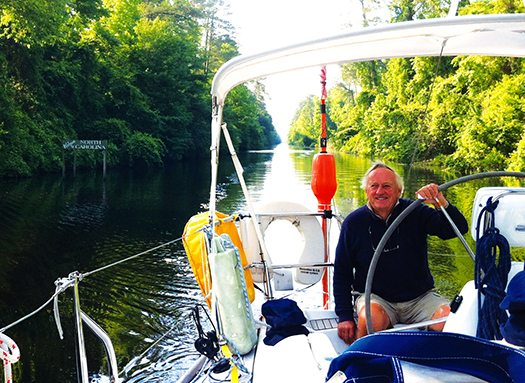
When you're told it's called the Dismal Swamp Canal, you've just got to go and see it. Neil Hegarty on Shelduck's wheel as she departs North Carolina via the Dismal Swamp Canal. Photo: Ann Kenny
FAULKNER CUP for best cruise in 2014.
Neil Hegarty (Crosshaven) with Shelduck, a 2003 Dufour 34. Shelduck's eight month cruise started with an east-west Transatlantic crossing, and then continued through the Caribbean including Cuba and on in detail up the East Coast of America until, after transitting the cheerfully-named Dismal Swamp Canal, they laid up for the hurricane season in the Atlantic Yacht Basin just north of Cape Hatteras. While other crews were aboard occasionally, throughout the voyage Neil Hegarty (a retired architect who was formerly in the forefront of racing fleets) was crewed by Ann Kenny of Tralee, whose own boat, the Chance 37 Tam O'Shanter, is currently in the Baltic. So to balance the Atlantic experience, they then went on for three weeks of Baltic cruising in the perfect sailing weather which that great inland sea enjoyed for much of 2014.
STRANGFORD CUP for alternative best cruise.
Eddie Nicholson, who sails from Kinsale, has been cruising the American side of the Atlantic in considerable detail since 2008 with his 2007 Najad 440 Mollihawk's Shadow. The boat's name derives from the 70ft 1903-built schooner Mollihawk with which a relative, Commander Vernon Nicholson of Cork and his family, sailed across the Atlantic in 1948. Their intention had been to get to Australia, but in cruising the Caribbean en route they sailed in to the abandoned and deserted former Royal Navy port of English Harbour on Antigua. They'd barely settled in the anchorage when some guests from a nearby hotel found their way on board and asked to be taken for a sail. Thus was Nicholson Yacht Charters brought into being. Any Australian plan was soon abandoned, and Antigua as we know it today, the focus of Caribbean sailing and home to the RORC Caribbean 600, was showing its first signs of its new existence in the winter of 1947-48 thanks to the arrival of Mollihawk.

A long way indeed from the balmy breezes of Antigua where the schooner Mollyhawk made her new home in 1948. These are classic Greenland conditions as seen from Mollyhawk's Shadow during 2014, Photo: Pat Dorgan
Her near namesake has been spending recent summers in waters remote from the balmy delights of the Caribbean, as she has been up and around eastern Canada. In 2014 Eddie and his number one shipmate Pat Dorgan combined forces to bring the much-travelled boat home via Greenland where, on the West Coast, they got as far north as Illulisat which looks to be a perfectly charming spot, but it still contrived in mid-summer to have its entrance blocked by ice from time to time. In fact, this was a cruise to West Greenland which started in Newfoundland and concluded in Kinsale, and when you work out what all that means, then you're beginning to grasp the sheer diversity of contemporary Irish Cruising Club activity.
THE ATLANTIC TROPHY is for the best cruise with an ocean passage of at least a thousand miles, and it goes to John Coyne of Galway for a nicely-balanced cruise with Lir, his 1990 van de Stadt 10.4m steel sloop. Lir's voyage took her from Galway Bay south to northwest Spain, then across to the Azores, then home to Ireland to sail 1,219 miles from Ponta Delgada to Inishbofin, which is Atlantic cruising at its very best.
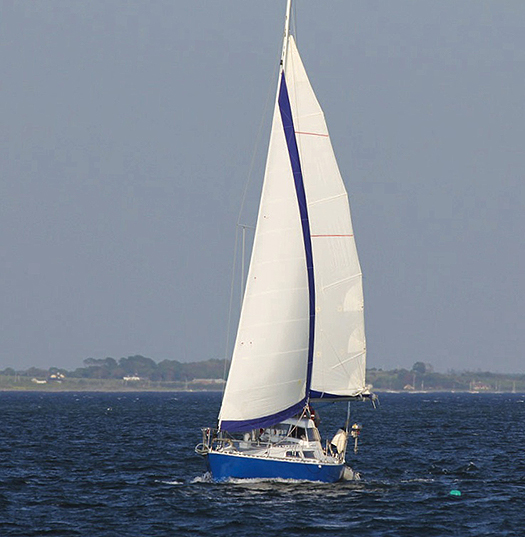
John Coyne's Lir sailing on her home waters of Galway Bay. In 2014 she sailed first to Northwest Spain, then to the Azores and thence to Inishbofin.
THE ROCKABILL TROPHY is for exceptional seamanship or navigation, and adjudicator Arthur Baker very cleverly turned it into a sort of Lifetime Achievement Award for Norman Kean of Courtmacsherry, who is of course the ever-diligent Honorary Editor of the Irish Cruising Club Sailing Directions, and in 2014 he was to be found on board various members' boats in some distinctly obscure locations, pushing the envelope for tiny anchorages.
THE FINGAL TROPHY goes to any log with a certain quirkiness which appeals to the judge, and for 2014 it is for Ian Stevenson and Frances McArthur's account of the early-season cruise of the 1994 Beneteau First 42s7 Raptor from Strangford Lough to northwest Spain for much port-hopping, then back across Biscay to cruise South Brittany in considerable detail, then home to Strangford – 2124 miles in all.
THE WILD GOOSE CUP, presented by the late Wallace Clark whose writings on cruising were universally admired, is for a log of literary merit. Theoretically it could be won by a cruise of just a hundred miles, but for 2014 it is the stylishly recounted story of the 2800 miles sailed by the Tony Castro-designed CS 40 Hecuba from her home port of Cascais in Portugal down to the Canaries, thence to the Azores, then back to Portugal, which most deservedly sees John Duggan awarded the trophy.
THE MARIE TROPHY - best cruise by a boat less than 30ft.
The little 1894-built cutter Marie was the first boat to be awarded the Faulkner Cup in 1931, and this trophy celebrating her memory is a reminder that the ICC is for boats of all sizes. With his part-owned Moody 27 Mystic, Peter Fernie of Galway fits well within the upper size limit for this award, yet with a crew of very senior sailors he'd himself a fine old time cruising from GBSC at Rinville to Kinsale and back, visiting all the best ports and anchorages in between.
THE GLENGARRIFF TROPHY is for the best cruise in Irish waters. Curiously enough, while there may have been boats which got round Ireland as part of other ventures, there was no specifically round Ireland cruise to be eligible for the ICC's Round Ireland Cup, which dates back to 1954. But the newer Glengarriff Trophy has a wider brief, and it goes to Brendan O'Callaghan of Kinsale for a cruise from Dun Laoghaire northabout to Rossaveal in Galway Bay in the Westerly Fumar 32 Katlin, with many of those unplanned yet hugely entertaining meetings along the way with other cruising boats, which is what true cruising is all about.
THE PERRY GREER BOWL is for the best first log by a new member. They seldom get as good as this, as Justin McDonagh of Killarney's debut account of his family cruise with the 2010 alloy-built van de Stadt 12m sloop Selkie takes us from the Canaries to the Caribbean, thence to Maine via Bermuda, and finally to New York, a wonderful achievement by any standards.
THE FORTNIGHT CUP is for the best cruise within 16 days.
In 2010, 2011 and 2012, Fergus and Kay Quinlan of Kinvara with their own-built van de Stadt steel cutter Pylades were awarded the Faulkner Cup three years on the trot as their fascinating voyage around the world rolled on. But in 2014 they showed they could cut the mustard when time was limited. Pylades headed north from Galway Bay and by the time they returned they'd been to islands as various as Tory, Barra, Eriskay, Canna, Mull, Colonsay, and Inishturk.
THE WYBRANTS CUP is for the best cruise in Scottsh waters, which may seem an odd trophy for an Irish club, but the ICC has a significant membership in the north, and the west of Scotland is their Southwest Ireland. For 2014 the Wybrants Cup goes to Matthew Wright who cruised the Sweden 38 Thor from Bangor far north along the Scottish mainland's west coast, but also found time for a detailed visit to Skye including the remarkable Loch Scavaig.
The Irish Cruising Club has several other trophies for specific achievements, and one of the most poignant moments of 2014 came in December when the ICC's JOHN B KEARNEY CUP for services to sailing was posthumously awarded to the much-mourned Joe English.
Last night, another trophy for special service and achievement went to Kieran Jameson of Howth, who received the DONEGAN MEMORIAL TROPHY for years of devotion to offshore sailing in a career which includes 15 consecutive Fastnet Races, nine consecutive Round Ireland Races, one Middle Sea Race, one Round Britain and Ireland Race, and one ARC.
Northern ICC member and environmental activist Brian Black was also honoured with the WRIGHT SALVER for his remarkable series of voyages far north along the challenging East Coast of Greenland - he got to72N in 2014.
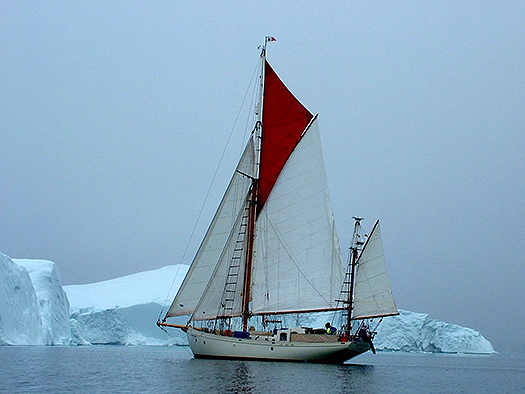
A steel-built gaff yawl? The 44ft Young Larry is unique in many ways, and now her owners Andrew and Maire Wilkes have been awarded the very special Fastnet Trophy
Another special award which has found a new home is the ICC's FASTNET TROPHY, which is not necessarily presented every year, and is for exceptional international achievement in any maritime sphere. The latest recipients are Andrew Wilkes of Lymington in England and Maire Breathnath of Dungarvan. They've been Mr & Mrs Wilkes for some time now, but their achievements are such that they deserve to be recognised as two remarkable individuals whose extensive cruising in the 44ft steel-built gaff yawl Young Larry is simply astonishing, as it has included a complete circuit of North America which took them through the Northwest Passage some years ago when it was still a prodigious challenge. During 2014 they took the opportunity to cruise in detail to many of the places between west Greenland and eastern Canada which they'd had to hasten past before, and awarding the Fastnet Trophy to them is proper recognition of a level of dedication to cruising which few of us can even begin to imagine.
Of course, not all ICC activity is to utterly rugged places, and one of 2014's more intriguing ventures was by Paddy Barry (no stranger to distant icy places himself) with his alloy-built former racer, the Frers 45 Ar Seachrain. He provided the mother-ship for a waterborne camino to Santiago de Compostella being made by the Kerry naomhog Niamh Gobnait, led by the legendary Danny Sheehy. This traditional 24ft craft has already been rowed round Ireland and up to Iona, and by the end of 2014's stage of the voyage to northest Spain, they'd got to Douarnenez in Brittany with the Biscay crossing in prospect for this summer.

Although the 24ft Kerry naomhog has been rowed round Ireland and up to Iona, the current voyage to Santiago is in another league. This year Danny Sheehy and his team plan to get to the other side of the Bay of Biscay from their current winter storage in Douarnenez. Photo: Patricia Moriarty
Altogether less serious but a date well worth celebrating was the 85th Anniversary of the foundation of the Irish Cruising Club at Glengarriff on the 13th July 1929. So Paddy McGlade of Cork organised an easygoing cruise in company for 35 boats in which the only totally rigid date was being in Glengarriff for July 13th, which was duly achieved. And prominent in the fleet was ICC member Oliver Hart's 70ft schooner Spirit of Oysterhaven. This is a boat which has to work for her living as a sail training vessel. But the ICC were able to take this comfortably in their stride, as the continuing steady sale of the voluntarily-produced Sailing Directions leaves the club with a modest financial surplus. In 2014, some of this was re-directed to provide eight bursaries so that young people could avail of Sail Training opportunities on Spirit of Oysterhaven during the Cruise-in-Company, an imaginative use of funds which worked very well indeed.
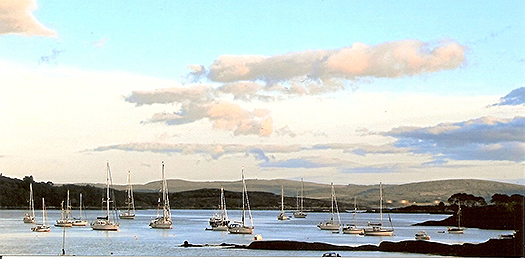
Part of the ICC fleet in Glengarriff for the 85th Anniversary. The smallest boat, Mick Delap's 24ft North Star, is on the right. Photo: Barbara Love
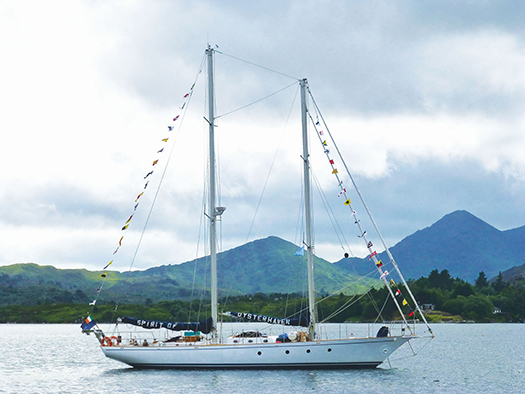
The biggest boat in the fleet – Oliver Hart's 70ft schooner Spirit of Oysterhaven was carrying a crew of trainees as part of the Cruise-in-Company
Just Who Do The Irish Sailing Association Think They Are?
#irishsailing – Ireland's national sailing authority has been going through turbulent times in recent years. With unprecedented expansion of ISA staff numbers as the country revelled in the boom years of the Celtic Tiger, the arrival of the inevitable and abrupt financial downturn found an Association bloated, unfit to cope, and out of touch with ordinary sailors.
High profile events, top level training and international participation had become so dominant in the ISA's range of activities that many of the ordinary sailors of Ireland already felt the Association was no longer relevant to their own low key personal pursuit of friendly sport afloat.
When the crash came, it led to a marked decrease in active sailing numbers as disposable incomes fell away. People focused on keeping their jobs and businesses afloat rather than their boats sailing, while many promising young sailors were forced to emigrate.
This new reality was reflected by the growing disillusion of club officers, who saw their membership subscriptions decreasing even while the ISA – which is largely reliant on subvention from the clubs for its own income – seemed always to be looking for more money. And at the height of the boom years, when all the major clubs had put through significant expenditure in developing their facilities to international standards, the ISA had shown its lack of contact with the reality of club life by proposing its own stand-alone National Sailing Centre in Galway, a facility which would in effect have been run in rivalry to the main clubs. To the mutterings in the grass roots were added the rumblings from above as major clubs threatened to withhold their annual payment to the ISA unless real reform was initiated. W M Nixon takes up the story.
In a classic grass roots revolution, club sailors Norman Lee from Greystones in County Wicklow and Bryan Armstrong from Sligo were at first rebuffed when they tried to voice their concerns about the ISA's increasing irrelevance to the needs of the vast majority of sailing enthusiasts, people at local level who were doing their very best to keep the sport alive through torrid times.
The Irish sailing community now owes these two men and their supporters a debt of gratitude, for they believed in what they were saying and they refused to be turned aside. Eventually, in November 2013 moves were in place to establish a Review Group for the urgent analysis of all ISA activities, and its personnel drew comprehensively on Ireland's remarkable pool of people with hands-on experience of running successful sailing events and organisations.
It was chaired by Brian Craig of Dun Laoghaire who has headed up the organising team on more major and notably successful international sailing events in Dublin Bay than probably anyone else, and its able personnel included two former ISA Presidents - Roger Bannon of Dun Laoghaire and Neil Murphy of Malahide and Howth - who had both been noted for their skill in running a tight ship when they were in charge. With them was highly regarded International Race Officer Jack Roy of Dun Laoghaire, and renowned sailmaker/activist Des McWilliam of Crosshaven, who each year is inevitably seen in busy involvement afloat in more Irish sailing centres - large and small - than anyone else in the boat world.
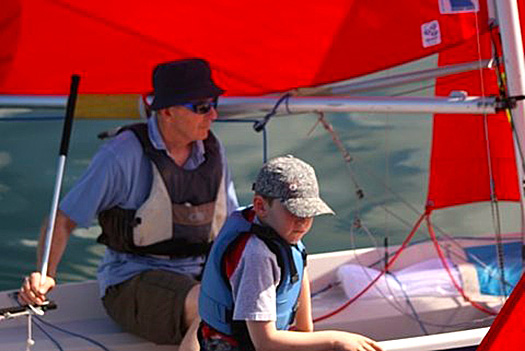
Bryan Amstrong of Sligo on the helm for a Mirror race
Also on board was one of the men from the barricades, Bryan Armstrong of Sligo. His background in a relatively remotely-located club which nevertheless has a long and distinguished sailing history made him uniquely qualified to voice the concerns of the grass roots. And we have to remember that all these people were giving voluntarily and generously of their time to this project in a period when Irish life was largely a matter of just getting through each day, while staying economically afloat was something of an achievement.
Primarily, the Review Group's function was to analyse the Association work on behalf of ordinary club sailors, as it was agreed that the Olympic and High Performance Divisions of the ISA's activities – which receive direct Sports Council grants – were in effect functioning as a different entity.
The Strategic Review Group was still work in progress when the ISA acquired a new President in David Lovegrove in March 2014, but by August the SRG published proposals which led to the setting up of a more formal body, the Planning Group. If this seems like a case of kicking the can down the road, it was anything but - these were people in a hurry, they'd got through the first stage of analysing areas where action was required, now they had to be more structured in coming up with clearcut ideas and concrete proposals.
This new Planning Group, which went into action in early Autumn 2014, was chaired by Neil Murphy, and its members included ISA President David Lovegrove, ISA Board Member Brian Craig, Ruth Ennis, Peter Redden, Sean Craig, and ISA CEO Harry Hermon, with noted Dun Laoghaire events administrator Ciara Dowling to provide administrative support.
They had their draft plan ready by mid-December 2014, and on January 21st 2015 Neil Murphy and his group publicly unveiled their analysis and proposals for the first time at a well-attended and very representative meeting in the Royal St George YC in Dun Laoghaire.
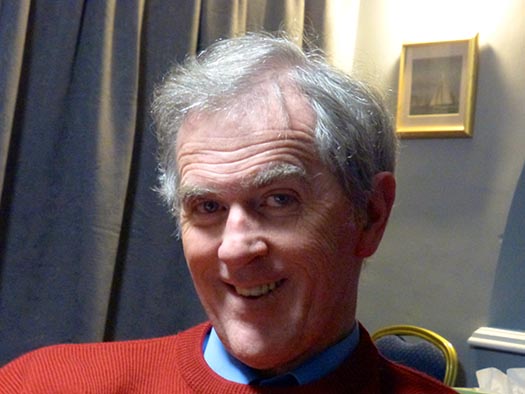 Neil Murphy is a former ISA President who, in addition to extensive experience as a Race Officer, is a typical club sailor, racing a Puppeteer 22 out of Howth. Photo: W M Nixon
Neil Murphy is a former ISA President who, in addition to extensive experience as a Race Officer, is a typical club sailor, racing a Puppeteer 22 out of Howth. Photo: W M Nixon
While those involved in setting the ISA on a healthier course are mostly working on a voluntary basis, it has to be said that the PowerPoint presentation and the printed material was of the highest professional class. In fact, it was much better than many professional shows I've been to, and the level of thought which went into a wide range of questions from the floor answered by Neil Murphy, Brian Craig and David Lovegrove generated a growing level of goodwill which concluded with Norman Lee voicing his congratulations and good wishes for this continuing process in which he and Bryan Armstrong had played such a key role.
So now we move on to the next stage – taking the ideas to the rest of the country. Doubtless you'll have noted the double meaning in titling this piece 'Just Who Do The ISA Think They Are?' In a first interpretation, that question is the one for which, let's hope, we are all now involved in working together in providing and implementing a satisfactory answer.
But equally, as the ISA Road Show gets out of Dublin to take this excellent presentation to a public meeting in Cork next week (it's in the Rochestown Park Hotel on Tuesday, Feb 17th, 7.0 pm to 9.0 pm) and then Galway the week after (Galway Bay Sailing Club, Tuesday 24th February 7.0 pm to 9.0pm), they'll be taking themselves into areas where experience of sailing administration long pre-dates the establishment of organised sailing on Dublin Bay.
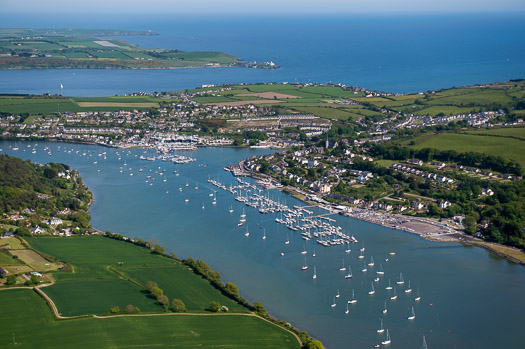 Crosshaven in the summer time. When we look at the natural advantages to be found here, it's little wonder that structured recreational sailing on Cork Harbour long-pre-dated any organised sport on Dublin Bay. Photo: Robert Bateman
Crosshaven in the summer time. When we look at the natural advantages to be found here, it's little wonder that structured recreational sailing on Cork Harbour long-pre-dated any organised sport on Dublin Bay. Photo: Robert Bateman
So you might well ask just just who do they think they are, these people from Dublin, going down to Cork to try to tell them how sailing should be organised? The nerve of them, doing it in a place where they've had organised sailing since 1720, and where the two biggest clubs – the Royal Cork and Kinsale – are both mighty establishments of international sailing repute which would remain so even were the ISA to disappear overnight in a puff of smoke...
And as for going west along the road to Galway, that will take them through Athlone where the Lough Ree Yacht Club dates back to 1770, while on the west coast the Royal Western of Ireland YC at Kilrush traces its origins back to 1828. Equally, further north along the Atlantic coast Sligo YC dates back to 1821, and in Lough Erne the club began in 1820. Yet the first club on Dublin Bay, the Royal Irish, only began as recently as 1831, and even then it barely hung in and had to be revived in 1846, with the pace being set in the meantime by the Royal St George YC, founded 1838.

Kinsale is another harbour which seems to have been designed with sailing primarily in mind. Photo: Kevin Dwyer/courtesy ICC

Kilrush on the Shannon Estuary had a club in being before there were any sailing institutions on Dublin Bay. Photo: W M Nixon
So in terms of sailing administration history, Dublin and Dun Laoghaire are only Johnny-come-lately places by comparison with just about everywhere else in Ireland. Yet thanks to the inevitable dominance of economic development, population growth and the strengthening centres of political power, we now find that sailing administration and decisions of national import are emanating from a place that, in terms of natural sailing advantages, lags far behind the rest of the country.
Oh for sure, Dun Laoghaire Harbour is a fabulous artificial amenity, and the advent of the new marina at Greystones has already been seized upon as greatly increasing the "cruising" options of Dublin Bay. But let's face it, Dublin Bay is really only good for racing, specific day sailing and training, whereas Cork Harbour and Kinsale provide such a variety of opportunities for interesting race courses, mini-cruises with multiple destinations and what have you, that in effect they're not just in a different part of the country – they're a different country altogether.

Dun Laoghaire is a totally artificial facility, and sailing options on Dublin Bay are limited. But it's inescapable that this is the primary point of leisure access to the sea for Ireland's largest and most affluent population. Photo: Kevin Dwyer/courtesy ICC
All of which adds to the difficulties of creating a meaningful national authority with which every sailing person can identify.
This business of Dublin v The Rest is not unique to sailing, of course, but when you have a specialist sport with multiple sub-branches of activity, the problem is exacerbated.
So please bear this in mind if you take yourself along to the meetings in Cork or Galway during the next ten days. This really is a genuine attempt to base the ISA within the sailing community at an everyday level of usefulness to all, with scope for growth while enhancing existing structures, and input from the sailing community at this stage will help in developing the ideas and initiatives proposed.
While the draft ISA Strategic Plan 2015-2020 very definitely puts the emphasis back on to the need for healthy well-run clubs as the basis for the sport, there was initially a feeling at the meeting on January 21st that the new-look ISA is not supportive of commercial sailing schools. In fact, what the new-look ISA hopes to do is encourage training schemes within clubs, while at the same time supporting commercial sailing schools where the demand is such that no club could realistically cope while maintaining its essential club ethos.
Going into this in more detail in a personal meeting this week with Neil Murphy, who is a Chartered Quantity Surveyor, we talked around the fact that a thriving club scene is central to the spirit of Irish sailing, and he was musing on the success of Sutton Dinghy Club where Hugh Gill heads up what is in effect a commercial sailing school within a club setting.
In fact, what Murphy would hope to see emerge at larger population centres is sailing's equivalent of the public golf course. Anyone who has used a public golf course will be aware that the proprietors are usually mustard keen to encourage the formation of a "club" within their customer base, and there is no reason why this shouldn't eventually take root in Irish sailing, providing access to sailing at a fraction of the cost of joining an established club.
It's not something which can realistically be objected to by established clubs trying to protect their own membership, as the people who would use a "public sailing club" would be those who simply couldn't afford to go sailing at all in the current traditional club setup.
Nevertheless support for the established club setup is central to the new Strategic Plan, and the provision of Regional Development Officers to serve clubs directly is very much to the fore in the new thinking. But in looking over the figures published with the report, it's good to note that the ISA works with no less than 80 recognised training centres, while an encouraging statistic is that there are now 24 secondary schools in Ireland which include sailing as a regular part of their curriculum. Admittedly it's a long way from the French setup where every schoolkid is entitled by law to one week of sailing and one week of skiing per year, but in a country where an aversion to being on the water used to be thought inevitable, it's a step in the right direction.
All these considerations of inexpensive sailing are a whole world away from the stories of recent weeks and days about the ISA's High Performance Division seeking a fund-raising executive who will be tasked with finding €2.75 million per annum through philanthropic and other donations in order to help the funding of top level campaigns which we're not allowed to call Olympic campaigns, as apparently that is copyrighted by the Olympic Council, so we call them High Performance instead.
But apparently Government departments aren't restricted by this limitation on the use of the word Olympic, for it was bandied about like nobody's business in this week's news that the government is spending mightily through the Sports Council, with sailing being number three in all Ireland in terms of current Sports Council funding, with a total tag of €1,289,900.
Of course it's not all for specifically Olympic sailing, but it covers 103 sailors from Optimists to the Olympics. Which is fine and dandy for those who are mad keen to race at the highest level, but most sailors in Ireland are much more interested in performing well within their chosen area and boat class, but with sailing being just part of a reasonably civilised and well-balanced life.
And as became evident at the meeting on January 21st, there's an increasing number of people who feel that sailing needs to realise that there's a sizeable population out there of folk who'd like to go sailing, but don't feel the almost religious vocation to own a boat.
With the rapid expansion of sunshine sailing holidays with boats and equipment readily available for hire at the destination, there's a strong feeling there's a real need for more of this in Ireland, even if we can't guarantee the sunshine. The suggestion brings us back to both the "public sailing club" concept, and the growing realisation by established clubs that they have to reach out to potential members by having boats available for sailing on a trial basis.

The Affordable Sailing Team – Norman Lee (right) with his brother Ken beside their campervan at last year's GP 14 Worlds at East Down YC on Strangford Lough. Photo: W M Nixon
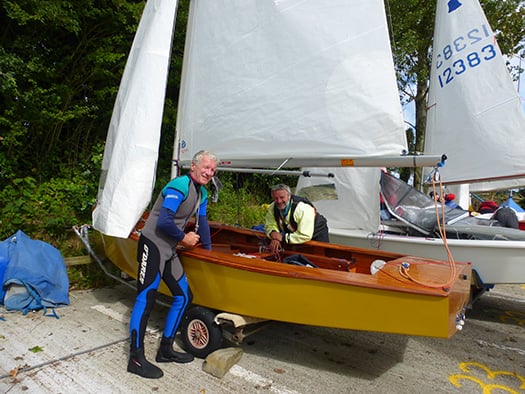
With their own very high can-do standards of boat maintenance, Norman and Ken Lee can keep their GP 14 in the competitive frame. Photo: W M Nixon
That said, the need to own one's own boat and tune and tinker with her to your heart's content is what sailing is all about for many of us, and Norman Lee is a classic case in point for this approach. He claims that his sailing costs him just €600 per year, though that of course is after he has paid for his well-tuned GP14, and he has long since written off the cost of the vintage camper-van which is home to the Lee Equipe when they hit the campaign trail.
Nevertheless the entire setup has to be outstandingly good value, and doing it in such economical style is part of the fun of it all. So when someone with Norman Lee's approach to sailing is prepared to get up at the big ISA public meeting in Dun Laoghaire and congratulate the team who have been working on the reforms which he and Bryan Armstrong set in train, then that is approval of a high order.
And as for just who or what is the ISA, can we maybe agree that ideally we all are the ISA, every last one of us who goes sailing or is even just interested in the sport, and it's up to us to keep it in line and encourage it to identify with and serve the ordinary sailor every bit as much as the high-flyer.

Private pleasure.....the 2014 GP 14 Worlds at East Down YC is about as high as many Irish sailors would expect or want to aim, and many are content with much lower-key regular club sailing. Photo: W M Nixon
2015 Will be 'Pivotal Year' for Irish Sailing Association
#sailing.ie – Irish Sailing Association (ISA) President David Lovegrove gives an update on a fundamental restructure of the organisation
Following the AGM in March 2014, the Board of the ISA received the report of the Strategic Review Group chaired by Brian Craig. In response to its extensive recommendations, the Board initiated a fundamental restructure to re-establish the organisation's relevance to its membership and focus its energies and capabilities on core activities.
Organisational and governance changes have been adopted together with a rationalisation of the professional team, a significant reduction in overheads and the disposal of surplus assets.
These changes allow resources to be re–allocated more directly into providing support at regional and club level and also reflect a change in emphasis from that of largely performing a regulatory role to one of being a source of active guidance at grass roots. This will be achieved within a cost structure which is realistically matched to the existing income profile.
In consultation with the Board and the recently formed Policy Groups, which are a valued source of expert advice on key areas of policy and activities, the Strategic Planning Group under the Chairmanship of Neil Murphy, is developing a new 5 year Strategic Plan 2015-2020. Following consultation with clubs and affiliated organisations in the New Year, this will be presented for consideration and approval at the next AGM in March 2015.
In the meantime, major changes to communications and PR are being implemented with a new website to be launched early in 2015, a collaboration agreement being signed with Afloat Magazine and a newly formatted high profile event, details for which will be announced shortly, that will pay tribute to our sailing achievers at both international and national level.
The training area will see innovative initiatives in 2015 with the launch of an online logbook for the Small Boat Sailing Scheme, the publication of a Junior Organisers' Handbook and the appointment of National Trainers for Sailing, Windsurfing and Power Boating. A Pathway for clubs looking to develop more double –handed sailing at local level for juniors will be finalised in 2015.
The ISA will also focus on developing a structured approach designed to make Coaching resources more readily accessible to sailors of all abilities and interests, including keelboat sailors, and ensure a trickle down benefit from the outstandingly successful High Performance programme.
With a revised and extended structure of Regional/Sailing Development officers, the ISA foresees working much more closely with Clubs, Class Associations and the Irish Cruiser Racing Association to coordinate plans for increased participation levels and sharing of resources. As part of this, it is planned to develop a comprehensive database on racing activities both at Club and at National level. Addressing this lack of information is regarded as key to the development of strategies to enhance and grow racing activity levels.
Cruising represents a large constituency of regular sailors and in consultation with The Irish Cruising Club and other established cruising groups, it is proposed to become more supportive in serving these interests by assisting in organising cruising symposiums, promoting Cruise –in–Company initiatives and providing reliable information on berthing facilities and visitor moorings around the country.
Increasing participation in sailing has long been a strategic objective of the ISA and if club membership and participation levels at many sailing events are an accurate indication of activity, it is clear that a major challenge to be confronted exists in making the sport more accessible and attractive to new participants. We also need to ensure that those who are regularly involved in the sport, but not necessarily as members of clubs, can find cost–effective ways of becoming more formally integrated into our club infrastructure.
During this re–direction of emphasis, it remains a major priority for the ISA to continue delivering its current range of services and competently discharge its responsibilities as the National Governing Body for Sailing.
2015 will be a pivotal year in executing this new direction for the ISA and success will be heavily reliant on the contribution and interaction of all sailors, whatever their interests or needs.
Finally, a big thank you is warranted to the professional team in the ISA and to all the volunteers who have energetically and generously contributed to what has been a very challenging eight months for the ISA.
David Lovegrove,
President
Posthumous Irish Cruising Club Award for Joe English
#icc – At the Annual Dinner of the Irish Cruising Club held at the Royal Cork Yacht Club last Saturday night its Commodore Peter Killen presented the John B. Kearney Cup to the family of the late Joe English together with a citation which read as follows:
The John B. Kearney Cup: Awarded for outstanding contributions to Irish sailing:
To Joe English for an outstanding career as a word–class sailor sailor. He skippered NCB Ireland in the Whitbread Round The World race in 1989-90, took part in the same race on 'Tokio' in 1993-4, participated in many Admiral's Cup races and was involved in a winning America's Cup team. In 1979, while based in Sydney he competed in several major events including the Southern Cross and Kenwood Cup series. In 1980 he won the one ton sailing cup with Harold Cudmore on the Tony Castro designed 'Justine' and also won the two ton cup in Sardinia a week later. Joe was central to the development of the 1720 sportsboat. Diagnosed with early onset Alzheimers disease at age 51, he died at age 58 on November 4th, 2014.
Joe's wife, April, and son Robbie accepted the award on behalf of the family.
Marinas, Yacht & Boat Berths – Has Failte Ireland Been Lost at Sea In Recent Years?
#marinetourism – Yet another Failte Ireland Marine Research initiative is taking shape to examine the coastal infrastructure for leisure sailors of all kinds, and how facilities might be developed to attract visitors from abroad, while better serving the home fleets. In view of this new research programme, W M Nixon returns to the topic of Dunmore East's potential for development, and sets it in the national context.
Every port in Ireland should be so lucky as to have someone like Harry McLoughlin as Harbour Master. Down in Dunmore East, he's passionate about fulfilling the potential of his picturesque harbour. And it's no easy task, as Dunmore is trying to cope with meeting the demands of a growing home port fishing fleet, while the numbers seeking berths can fluctuate rapidly with visiting boats.
At the same time, the peak summer months will see leisure craft arrive in unpredictable numbers, keen to avail of any sheltered berthing to be had in a port whose strategic usefulness will be obvious to anyone with experience of cruising the Irish coast. And on top of that, from time to time cruise liners will call by, anchoring off and seeking to disembark passengers via their ship's tenders in this characterful little port, where virtually every inch of quayside and pontoon space is already taken by a wide variety of boats.
This provides a colourful and crowded scene, which makes it even more attractive for visitors who might be jaded by the usual big port/cruise liner berthing routine. But it's a headache for a harbour master who has to juggle the often conflicting requirements of different boat interests.
Last week's series of photos gave a snapshot of a few moments in a Dunmore East summer afternoon which well illustrate the challenges that Harry McLoughlin constantly faces. The reality is that the new industrial-style 40 metre pontoon along the East Pier under the lighthouse is a multi-purpose facility. Certainly it has been installed with leisure visitors in mind. But thanks to the welcome growth in the Dunmore East fishing fleet in the last couple of years, there are times when the dedicated pontoons for smaller fishing craft in the southwest corner of the harbour become impossibly crowded. The main quays have to be left clear for large trawlers unloading their catches and their other berthing requirements. So when there's so much pressure on space, some smaller fishing boats are sent across to the Visitors' Pontoon if it happens to be clear, and no visitor is expected.
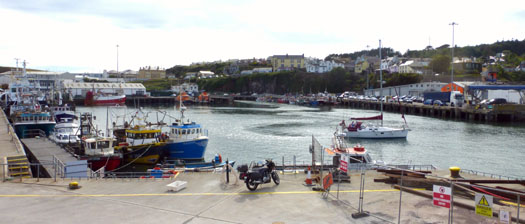
No room at the inn.......an unannounced and unexpected cruising boat finds no space available when pressure is on the berthing at the small craft pontoon. Photo: W M Nixon
It has to be confessed, though, that some of us when cruising are oddly reluctant to call ahead to the Harbour Office when approaching a new port. We prefer just to come in round the pierhead, hoping to be able to choose our own favoured berth without any communication with officialdom at all. It's part of the attraction of cruising when you can do this, as it adds to the sense of freedom which commanding your own small boat is supposed to confer. But the reality is that in a place like Dunmore East, you just have to call ahead, and that is what last week's photos, in the final analysis, seem to be all about.
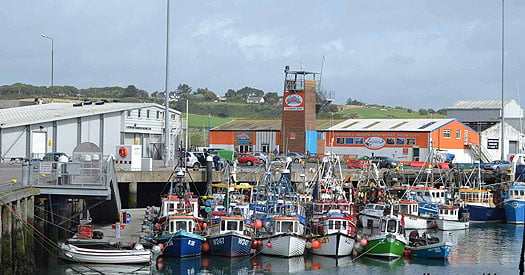
When they pack them in at Dunmore East, they do it big time. A notably trim fleet of smaller craft crowded at their own pontoon. Photo: Aileen Egan
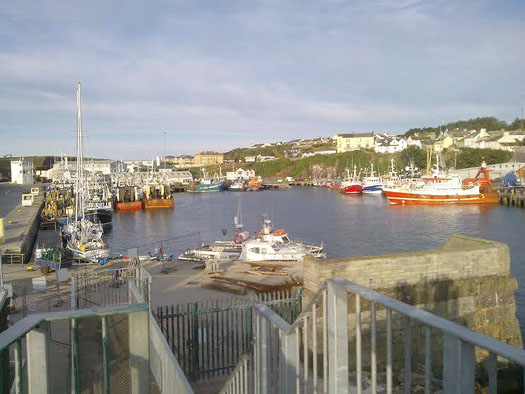
The big boys are in town. Quay space has to be kept available at all times for the comings and goings of larger trawlers. Photo: Harry McLoughlin
But with so much pressure on space, how can Dunmore also cope with the special demands of cruise liner passengers – many of them far from the first flush of youth – disembarking from ship's tenders? Well, in the spirit of community which keeps Dunmore going, the secret is the cruise liner passengers are allowed to come ashore on the usually hallowed territory of the RNLI pontoon.
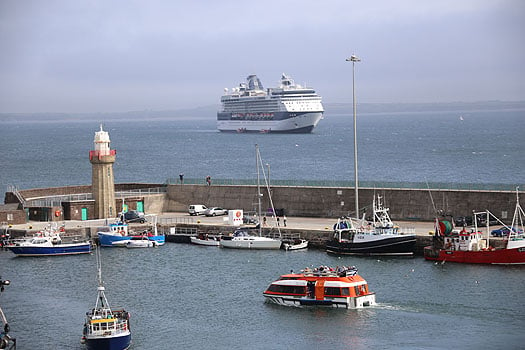
An example of a port harnessing different activities and working together with yachts, trawlers and, in the foreground, cruise line passengers disembarking at Dunmore East. Photo: David O'Brien
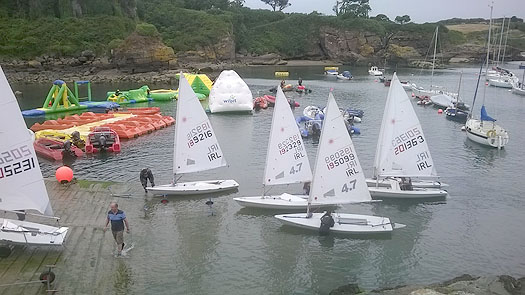
The extended slipway at Dunmore East, which has an abundance of younger sailors who would benefit greatly from an improved harbour. Photo: Harry McLoughlin
That such a temporary re-allocation of resources is necessary from time to time reinforces the genuine demand for improved facilities at many of Ireland's key ports. It will be interesting to see how the priorities are high-lighted by the international research programme which is being implemented under a new Failte Ireland initiative, with an advisory panel of Norman Kean, who researches and edits the Irish Cruising Club Sailing Directions for both the book and on-line versions, Paal Janson the General Manager of Dun Laoghaire Marina, representing the Irish Marine Federation, and Gail MacAllister of the ISA.
We could be forgiven for being a bit bewildered about some of this. Exactly seventeen months ago, in this blog on Saturday April 13th 2013, we were welcoming an up-coming report for Failte Ireland, titled: A Review of Tourism Policy Regarding the Funding of Marina and Berthing Facilities in Ireland. Ultimately known as the Fisher Report and resulting from the work of an agency from outside Ireland, it has since been gathering dust on some shelf. Now, that dust has apparently congealed into aspic with the realisation that the report was so vague and general that it didn't provide any sufficiently clearcut conclusions and proposals to form the basis of a policy.
The questionnaires which are being developed will be targeted at Irish, British, French and German markets. Making a point of ensuring that Irish leisure sailors are included in the equation strikes me as essential, for not only are we often sailing visitors in our own country, as our island's coastlines are long enough and sufficiently varied to make this the case, but visitors from abroad are attracted by the vibrant Irish sailing scene. Thus anything which provides better facilities for our own sailors will be beneficial in a much wider context.
The guidance of someone as experienced in cruising as Norman Kean will be invaluable, as the framing of the questions is vital in producing a worthwhile result. Then too, Norman is at the heart of the Irish sailing and boating scene, both with his key role in the internationally-praised Cruising Club Sailing Directions, and the fact that he is based at Courtmacsherry in West Cork, a friendly port which has shown it knows a thing or two about how to make visiting cruising boats feel welcome, and wish to come back again.
So we can be sure that the doughty Norman will accurately and eloquently represent the views and requirements of the Irish boating community, whose enthusiastic approach to sailing in all its forms is an important part of the package for boating visitors. This is all-too-frequently overlooked by the powers-that-be, who are so keen to tot up numbers of new visitors that they overlook the existence and needs of Ireland's large home sailing community, all of whom are more than willing to be personal hospitality managers when visiting boats come to call.
But in any case, regarding the ultimate value of market research, we should remind ourselves of Henry Ford's opinion on it, as we did back on April 13th 2013. The great car pioneer and manufacturer said that when starting out in business, if he'd asked his potential customers what they wanted, they'd have demanded a faster horse...
It seems that with the Fisher Report, we didn't even get a slow horse, we got a lame duck. So for the moment, instead of setting up a ponderous set of questions, Afloat.ie will simply dream on. What do we want for good cruising in Ireland? Well, setting aside those who insist that a giant astrodome should be installed to cover the entire country before they'll come near the place, we have a wish list that begins with good sailing which is sometimes sufficiently challenging to make the completion of each passage a satisfying experience. And all of it to be done with a background of attractive coastal scenery.
As for making safe passages, and then getting the best from each haven at the end, we'll know that the Irish Cruising Club Sailing Directions are an indispensable guide. Ideally, we'll be in an area with an abundance of natural anchorages where we can put down our own anchor without fear of fouling abandoned moorings or other detritus on the seabed. If there are reliable and regularly-serviced visitors moorings, that's fine and welcome too. But we who cruise the Irish coast, and the western seaboard in particular, do so in the knowledge that any proper cruising vessel will have her own more-than-adequate ground tackle.
If we happen to be sailing along an Irish coastline which lacks an abundance of natural harbours, we would like handy artificial harbours – preferably with marinas – at about 35 mile intervals or even less, as 35 nautical miles seems to be the magic distance which is easily attainable in one day, yet its completion really does make you feel you've moved on.
This sense of needing to move on is part of what cruising is all about. It satisfies some hidden genetic urge which most of the time is dormant in us, but given half a chance, there is indeed a gypsy in our soul. However, having satisfied our wanderlust by the modest total of 35 or so miles made good, what will we expect to find ashore?
Your complete dyed-in-the-wool cruising person is often content simply to stay on board enjoying the natural grace which is provided by a boat lying comfortably to her own anchor. Be sure, though, to choose a spot where your pride-and-joy won't be uncomfortably tide-rode, which so often turns out to be the case in what looked to be a snug if narrow inlet.
In their wellnigh perfect anchorage, these traditional cruising folk will be happy to dine aboard. At such times, you realise that a good sea cook is a pearl beyond price, much more valuable – in this age of sensitive auto-helms – than a top helmsman for the general welfare of the crew and the success of the cruise.
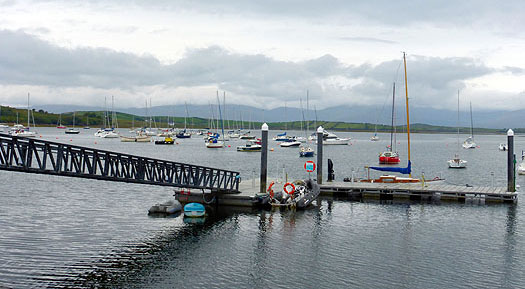
Mayo SC's landing pontoon at Rosmoney on Clew Bay is an impressive piece of work. Photo: W M Nixon
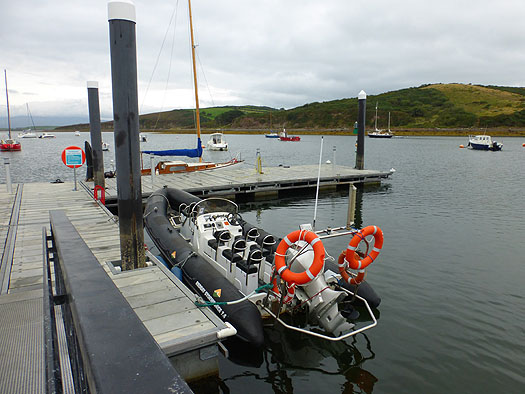
The attractive facilities at Mayo SC bring in a membership from all over North Connacht. Photo: W M Nixon
Such traditional cruising people, if they do go ashore, are quite happy to scramble up some awkward foreshore for a bracing hike on nearby moorland, or even climb a mountain or two. But the vast majority of us – and an increasing majority as newcomers arrive in cruising – prefer to get easily ashore from an anchored boat via the dinghy onto a good jetty, and ideally a landing pontoon - such as you see at civilised places like Mayo Sailing Club on Clew Bay – is both much safer, and more convenient.
However, let's face it, when cruising you're on your holidays. After a perhaps slightly rugged day at sea, there's no doubting the benefits conferred by a comfortable marina berth. Apart from the safety and security, there's the simple sense of freedom. While there are those who enjoy the restricted and aromatic confines of a cruising yacht, for many it can quickly become claustrophobic, and the freedom of personal movement which a marina confers on the cruising crew can be vital for preserving harmony. And it greatly broadening the options of what to do once ashore, because unlike the crew from an anchored boat reliant on one dinghy, crews in marinas can come and go as they please.
Perhaps it's the fact that they have this choice is one of the reasons why, by and large, cruising crews tend to stay as a group when they are ashore – they may even be celebrating the fact that they're still friends, and a marina can help in this.
As to what's needed ashore, basically it's good hospitality facilities within easy walking distance. The "easy walking" requirement cannot be over-emphasised. Once you're into a cruise, you're moving at a different speed in a different frame of mind, and too much walking on tarmac or cobblestones or whatever becomes simply tiresome. In fact, you'll have noticed that some experienced cruising folk are surprisingly willing to take a taxi if there's anything other than a short walk involved. For they also know that, coming off a boat, you're out of sync with road traffic – a cruising crew ambling along a busy road can be a hazard to themselves and a distracting menace for other road users.
So we're beginning to get the picture of our cruising crew's Irish dream port. It has to be colourful, characterful, and compact. Ideally, all facilities for every possible need, including repair, fuelling and re-storing, should be within easy reach from a marina berth with full-sized walkways and proper pontoons – you might be a bit rocky on your pins after a rough day at sea, and sea legs need something better than a cogglesome thin little finger pontoon.
From all this, it is clear that Kinsale is the Irish cruising port par excellence, even if the Yacht Club marina does get over-crowded betimes, and even if, when the ebb is running hard and there's a strong sou'easter blowing, the boats rafted along the outer berths have a bumpy time of it. Despite all this, Kinsale has so much to offer we can learn from it, and from other top cruising visitor places like Dingle and Howth while the new harbour at Greystones on the Wicklow coast is a fascinating example of a port in active transition from a small boat mini-haven to a proper harbour with marina and full facilities for multiple uses.
But equally there has to be fresh thinking about making the best of existing ports. In other words, the old notion that some ports should be exclusively designated as Fisheries Harbours is patently nonsense when those harbours are located in key positions with ready-made characterful port towns and villages as part of the package.
There still is some residual resistance in a few ports to the very notion of a marina being installed. But it should be seen in the broader context as an indicator of attractive peace and prosperity, every bit as much as a facility for visiting boaters who will be keen to spend their holiday money ashore. I was recently in Ballycastle in the far northeast corner of Ireland, and in going up the town we noticed a welcome air of prosperity. Buildings had been painted and generally spruced up. This was even more marked in the area down beside the little harbour, where there's a small but very useful marina, and the regular ferry leaves from its much-improved berth for Rathlin Island six miles away. We still think of it as the "new harbour and marina" at Ballycastle, although it has been around for some time now. But such facilities are put in for the long haul, and it is now that Ballycastle harbour's attractive sense of purpose and prosperity has had this beneficial spinoff for the mood of the town.
 The small but convenient and very useful marina at Ballycastle has played a part in the North Antrim town's improved perception of itself. Photo Kevin Dwyer courtesy Irish Cruising Club
The small but convenient and very useful marina at Ballycastle has played a part in the North Antrim town's improved perception of itself. Photo Kevin Dwyer courtesy Irish Cruising Club
Elsewhere in the north, one of our favourite ports is Ardglass, where one of the most strategically useful marinas on the entire Irish coast was slotted into a spare corner of what had formerly been a decidedly rugged "fishing-and-fishing-only" place, and the mood has been pleasantly lightened as a result.
 A handsome and obviously fast perfomance cruiser in the hoist at an Irish port – but where is it? Photo: W M Nixon
A handsome and obviously fast perfomance cruiser in the hoist at an Irish port – but where is it? Photo: W M Nixon
But for pure rugged essence of total fishing port, you just couldn't beat the Wild West atmosphere of Killybegs in Donegal. The fishing has been mighty, and there are now at least 23 multi-millionaires in the Killybegs area whose wealth has been drawn from the sea. Yet in recent years, the Killybegs attitude has softened slightly. The place has tidied itself up, and as one of the best natural harbor in the entire northwest of Ireland, it has put out some visitors' mooring for leisure craft, while serious cruising men visiting this challenging but rewarding area find that the Mooney Boats quayside yard with its massive travel hoist is a real boon.
Killybegs does have space where a marina could be installed to be handy to the town while not interfering with fishing boat needs, and judging by the quality boats flying foreign ensigns on the visitors moorings, its usefulness as a crew-change port is a particular asset, as the international airport at Knock isn't so very
far away.

Killybegs is the answer, with Mooney Boats a boon for boat visitors to Donegal. Photo: W M Nixon

Once upon a time, Killybegs was fishing, just fishing, and only fishing. But now the deep sea trawlers are well used to sharing their harbour with visiting yachts, in this case a couple of Dutch boats. Photo: W M Nixon
So if Killybegs can take aboard the idea of a marina, maybe the other mega-fishing-port of Castetownbere in southwest Ireland can do so too. That said, there is a hugely popular little marina already well established at the other end of Bere Island at Lawrence Cove, but a convenient facility at the western end of Bere Haven would improve cruising options.

The 78ft cruiser-racer Whisper contrasts vividly with the lifeboat in Castletownbere, a fishing port which might be able to find space for a marina. Photo: W M Nixon
In the cruising heartlands of West Cork, we can expect new movement on the long-proposed marina at Schull, which would greatly help in rationalizing pier use. But in bustling Baltimore there may be more of a challenge in creating a proper marina, as waterfront space beside the village is limited. As it is, the current berthing pontoon which juts straight out into the harbour can be a mixed blessing when there's a serious wind from the west, with the pitching and banging of boats and pontoon sections being a nuisance at best, and a real hazard at its worst.
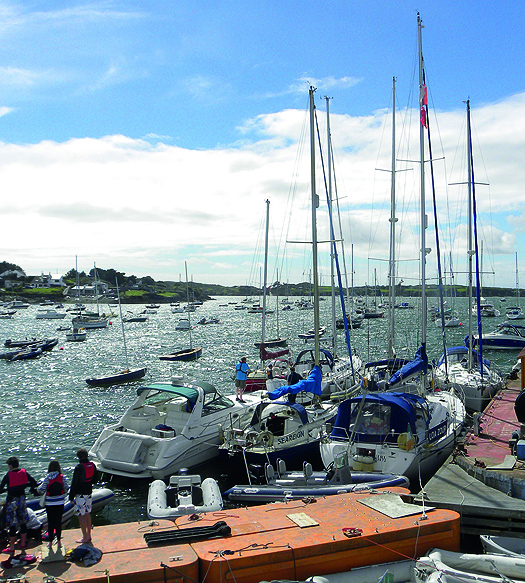
The berthing pontoon at Baltimore can become a decidedly exposed place when the wind is fresh from the west.
But all these places already have something of a range of choices, in Dunmore East there's just this one little bit of a harbour, and everyone wants a piece of it. I make no excuses for dragging out the dog-eared rough sketch of what a marina might look like if there was to be a realistic separation of fishing and leisure use, for while we do suggest that places which were originally exclusively fishing ports can be usefully modified to be partially leisure ports as well, there's no doubting the primary need of clearly defined boundaries between the two within the harbour confines.
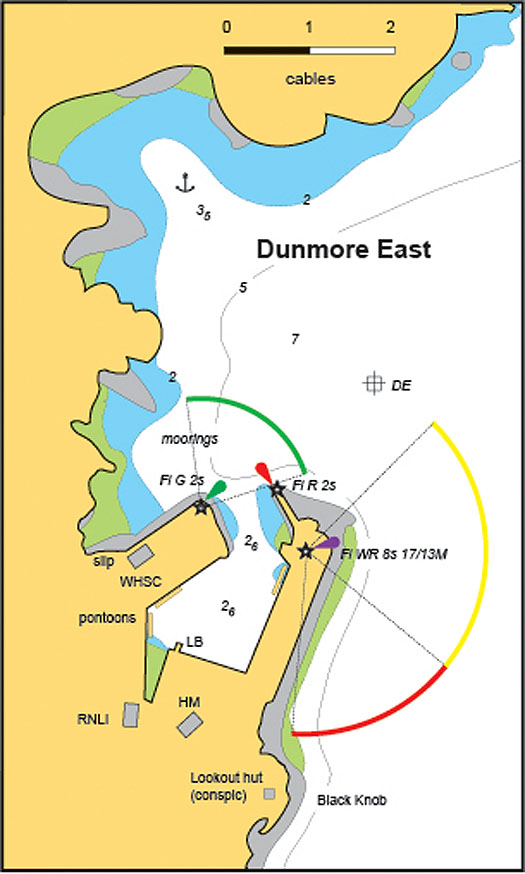
Dunmore East as it is today, and surely ripe for development
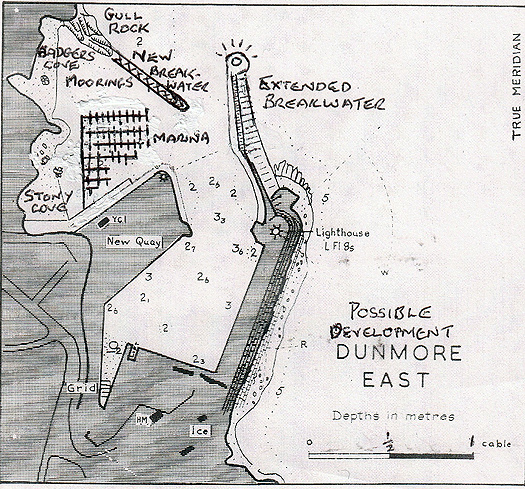 The possibilities for a marina at Dunmore East are suggested in this rough sketch
The possibilities for a marina at Dunmore East are suggested in this rough sketch
For there's no doubt we all wish the very best for Dunmore East. It very much wants to be a hospitable port, and can do it very well too, given half a chance. Harry McLoughlin was talking enthusiastically about some of the fine boats and great sailing people he has welcomed since he took over as Dunmore's Harbour Master in the Spring of 2013, and from 2014 he best remembers the great Jim Mottram.
Jim cruises alone in his pretty little Elizabethan 23 Reservation out of Christchurch in Dorset just outside the west entrance to the Solent, and over the decades he has logged some formidable voyages, down to Spain, and round Britain three times. But as his boat has a lifting keel which reduces the draft to 2ft 6ins, for 2014 he decided that a cruise to Ireland with a spell on the inland waterways would make for a change.
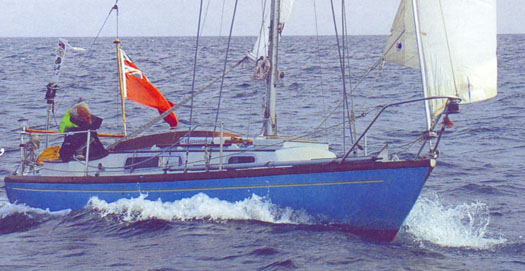
The most senior sailor – Dunmore East visitor Jim Mottram has cruised thousands of miles in his Elizabethan 23 Reservation.
So he arrived into Dunmore East early in the season, intending to go up the Barrow, across Ireland on the Grand Canal, then back to the sea again via the Shannon through Limerick. But after going up to Waterford from Dunmore, he reckoned the early-season surge down the River Barrow would make things unnecessarily difficult, so he cruised right round the south coast of Ireland and went up the Shannon Estuary to Limerick. There, he unstepped his mast, and motored north through Lough Derg and into the Grand Canal at Shannon Harbour, then right across Ireland to swoosh down the Barrow – which becomes even more lovely the further south you go – until in New Ross the manager of the Three Sisters Marina John Diamond set him up again, and on he went down to Dunmore East for a warm welcome and a celebration of his near-circuit of Munster.
Harry McLoughlin discovered Jim had a special birthday coming up while he was in Dunmore East, so he and his wife took the lone skipper along to the Waterford Harbour Sailing Club for a party to celebrate both the birthday and the success of his cruising since he'd last been with them.
And which birthday was Jim Mottram celebrating?
His 80th, of course.
Dungarvan Harbour Sailing Club 30–Berth Pontoon Will Attract Visiting Boats to Waterford
#tourism – A new Dungarvan pontoon facility to provide short term temporary berthing on the Copper coast in West County Waterford has been opened. The facility opened by Dungarvan Harbour Sailing Club will provide berthing for approximately 30 berths on the West Waterford coast. The new facility replaces an older interim structure which had been in place since the early 1990s.
The facility is for Club members on a daily fee basis as well as access for visiting boats. It is expected the latter aspect will support the development of marien tourism on the West Waterford coast.
The facility was opened on 11th of May the Minister for Agriculture, Food and the Marine. Simon Coveney T.D.
Speaking at the opening, the Commodore of Dungarvan Harbour Sailing Club, Joan Moloney, said "This is a proud day for sailing in Dungarvan as it represents another important development in the 68 year history of the club. The modernisation of the pontoon facilities will provide safer boat access for families and sailors and will support tourism development in the town". She then went on to thank those in the club who have worked tirelessly to bring the project to fruition.
Moloney thanked Dungarvan Town Council and in particular the unstinting efforts of Joe O'Flaherty the recently retired Town Clerk and Eoin McGarry of McGarry Construction was also praised for his effective and efficient installation of the facilities together with the suppliers Inland and Coastal. During the project a late technical hitch prevented dredging work being undertaken in addition to the pontoon installation.
Wicklow Lifeboat Tows Cabin Cruiser To Safety
#RNLI - Wicklow RNLI's second call-out this bank holiday weekend – after Friday's early morning tow of a stricken yacht - saw two on board a 13m cruiser brought to safety early today (4 May) after their vessel suffered engine failure.
The station's all-weather lifeboat was launched at 6.44am and located the vessel a short time later, two miles east of Wicklow Harbour.
Volunteer crew member Terry Sillery went on board the motor cruiser to assist with establishing a towline.
Weather conditions in the area at the time were blowing a westerly force three wind and there was poor visibility.
The motor cruiser was on passage to Wales when it developed engine trouble. The owner put down an anchor so the vessel would not drift and contacted the Irish Coast Guard for assistance.
The stricken motor cruiser was towed into Wicklow Harbour and safety secured alongside the East Pier at 7.40am.
The crew on the call-out were coxswain Dave O'Leary, mechanic Tommy Murphy, Terry Sillery, Carol Flahive, Brian Sinnott, Connie O'Gara, John Vize and Alan Goucher.
#eastcoastports – Ireland's east and north coasts may lack the cruising glamour of the south and western seaboards, but W M Nixon suggests that the ICC's East & North Coast Sailing Directions points the way to an area with its own special charms. And he ponders a coastal mountain-measuring quandary in this blog first published in March 2014.
Now here's a thought. Could it be that Scrabo, the tower-topped hill which dominates the northern waters of Strangford Lough, is not as high as officially reckoned? Could it be that its recognised height of 538ft (which doesn't include the 125ft height of the tower itself) is a bit optimistic?
Such notions come from contemplating aspects of the new 12th Edition of the Irish Cruising Club's Sailing Directions for the East & North Coasts of Ireland, which is now on sale at £29.95 or €37.50. It's worth every cent, not just for those planning to cruise the area, but simply if you sail from any of the ports covered. And the interest lies not just in the essential information conveyed for safe navigation and pilotage along these many miles of varied coastline, but also in the implications of that information in a larger context.
As the ICC publishes two books with the most recent massive 13th edition of its best-selling South & West guide appearing last year, inevitably people will compare the two areas. And equally inevitably, the east coast can appear a rather humdrum sort of place by comparison with the lotus-eating charms of the south coast, and the spectacular glories of the west, while the north coast sometimes seems just too challenging to be contemplated at all. However, in one category the east and north coasts put the south and west coasts in the ha'penny place. The eastern and northern seaboards are absolutely tops in tides.
On the west and south coasts, apart from the Shannon Estuary and maybe Achill Sound and perhaps Cork Harbour entrance at Springs, tidal streams are relatively weak on the entire coastline going westabout between Hook Head in Wexford and Bloody Foreland in Donegal. And yes, I too have shot the tidal rapids at Lough Hyne, but that's a special case. Otherwise, it's useful to have the tide with you along the coast, and it's best to avoid wind-over-tide at major headlands. But generally, unless you've a long passage planned you can come and go at sociable hours for day sails rather than having your schedule dictated by tide.
Yet if you're voyaging that same journey from Ireland's southeast corner to the far northwestern extremity via the east and north coasts with the absolute shortest distance being 282 miles, the tidal streams are dictating your times of coming and going except between Skerries and Ardglass on the east coast, and west of Malin Head on the north. Elsewhere, it's conveyor belt coastline, and anyone sensible will go with the flow.
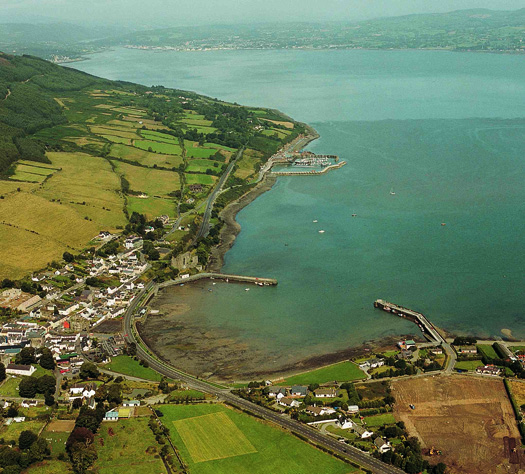
Carlingford Lough is one of several inlets on these coastlines whose narrow entrances have strong tides. The mediaeval little township of Carlingford has its own largely drying harbour (foreground), but the marina further along the shore is accessible at all states of tides, and has facilities on site. However, village waterfront hospitality resources are somewhat spread out, as the hospitable Carlingford Sailing Club (extreme right), with its own slipway and welcoming clubhouse, is at a significant distance from the marina. Photo courtesy ICC/Kevin Dwyer
In addition, where natural harbours and sheltered inlets exist, in a surprising number of cases on the east and north coasts the entrances are narrow, and pushing the tide to get through can be a serious challenge. This is the case in Mulroy Bay, Lough Foyle, Larne Lough, Strangford Lough and Carlingford Lough. But the great inlets of the west, particularly the magnificent rias of the southwest, are drowned river valleys which close in only gradually, resulting in much gentler tides.
Strangford Lough's entrance by contrast is totally tide-dominated, and many local cruising boats solve the problem simply by never leaving the place. But as a study of this new book (yet another extraordinary effort from the ICC's remarkable sailing directions team of Norman Kean and Geraldine Hennigan) successfully reveals, Strangford Lough is indeed a wonderful world unto itself, and you could happily cruise here for a week without feeling the need to venture into the dark unknown to seaward beyond The Narrows, where the tides hit 8 knots and more, and the whirlpool of the Routen Wheel waits to trap the unwary.
It's the business of the sea pushing in and out Strangford Lough twice a day (and generating electricity while it does so) which provokes the thought that maybe Scrabo is not as high as generally thought. The hill is simply known as Scrabo, which sounds like somewhere in Transylvania – it could be Dracula's summer residence - but apparently it means nothing more exciting than "cow pasture" in Gaelic. They were hardy cattle in them days, as it can be rugged enough on top, for Scrabo's location relative to the serene inner reaches of Strangford Lough emphasises its exposed nature.

Strangford Narrows, with a smooth yet powerful stream, though it can be anything but smooth when it meets open water and an onshore wind. The tides in the Narrows provide so much guaranteed energy that they have been harnessed by this generator to provide sufficient electricity for a thousand homes. Photo: courtesy ICC
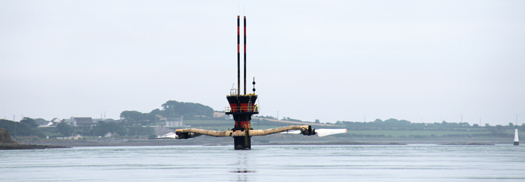
The Seagen tower with its turbines raised clear. Like this, it can be a hazard for sailboats passing too close. Currently, the scorecard reads: Seagen-1, Yacht Masts-0. Miraculously, no-one was hurt. Photo courtesy ICC.
But the point is that high water in those remote inner reaches and in Strangford Lough generally occurs a clear two and a half hours after high water in the Irish Sea. Thus down at the Narrows, the water may be still pouring into the lough, yet out in the Irish Sea the tide has peaked, the ebb is running north, and the sea level has been falling for a good two and a half hours by the time the final surge has reached the top, way up at the flat shore below Scrabo.
So it occurs to me that, could we but somehow measure by the most precise methods exactly from the centre of the earth, then mean sea level at Scrabo would always be less – maybe even a metre less – than on the ocean generally. And for all hills, whether it be Scrabo or Everest or whatever, the height above sea level is the gold standard. So the surface of the sea must curve over and above the curvature of the earth.
My ignorance of modern surveying methods being almost total, doubtless this idle speculation will bring down scorn, and we'll find that crude measures of sea level by observation at a local position have been long since superseded by more scientific techniques. Probably these days sea level has little enough to do with the level of the sea. But if you're someone who likes to muse on such things as the true height of Scrabo in the light of Strangford Lough's wayward tides, then you've the mind of a cruising person, and you'll find the new guide a delight, particularly if you reckon the east coast has been getting a raw deal in the perception stakes.

The Economic Corridor. Dublin Port looking seaward at a quiet period between ship movements, which currently run at 40 per day. Grand Canal basin is bottom right, while the ancient maritime community of Ringsend is just across the River Dodder. The Dodder's east bank, now lined with corporation flats, used to be a hive of activity with at least four boatyards on the foreshore. Poolbeg Y & BC marina is beside Roingsend. Photo courtesy ICC/Kevin Dwyer
That said, it has to be admitted that between Dublin and Belfast, the "East Coast Economic Corridor" may sound glamorous to business folk, but it can make it all seem rather workaday to the rest of us when sailing the nearby sea. Then too, the dictation of the tide in setting the times of your passage-making gives a sense that you're commuting along the coast, rather than cruising it. Finally, while there may be several handsome ranges of hills and mountain along both coastlines, only in certain areas is there significant indentation of the coastline to give that air of excited anticipation as to what might be round the next corner. By contrast in the south and west you've many variations on the sense of anticipation exemplified by the always uplifting experience of coming northwards through Dursey Sound and suddenly seeing the entire panorama of the Kerry mountains revealed in all their purple glory.
But living in such a state of constant excited anticipation would be damaging for anyone's health. The real business of life is making the best of the hand you've been dealt, and these days the east and north coast deal is much enhanced by greatly improved harbours and marinas. These make for much more convenient access to port towns, which in their turn provide a better hospitality package which adds greatly to the enjoyment of a day's sail along a coast which may have been looking very well indeed.
Not least of the factors in this is that, along the east coast at any rate, it rains less than on Ireland's other coastlines. Sometimes a lot less. And it's at its best when the wind is the Atlantic breeze, the westerly off the land. When "the wind is off the grass", as the crewmen in the Irish Lights vessel describe their ideal conditions for working at buoys and other navigation aids, then sailing Ireland's east coast is very pleasant indeed.
Although the east coast officially begins at Carnsore Point, the ICC Directions sensibly begin just round the corner at Kilmore Quay, whose transformation by Wexford County Council into a useful sailing/fishing harbour has greatly changed everyone's perception of the area. And just to show that the Saltee Islands can now be seen at the very least as an interesting day cruising destination from Kilmore itself, the book includes a useful photo of the fair weather anchorage on the southeast coast of the Great Saltee.

In times past, the Saltee Islands were seen by cruising folk as somewhere to get past as quickly as possible. But now that there's a fine little all-weather harbour and marina at Kilmore Quay, this photo of the fair weather anchorage off the southeast coast of the Great Saltee is of special interest. Photo courtesy ICC.
Heading up the east coast, the favoured first port of call tends to be Arklow, where developments in recent years have been an intriguing illustration of the way Ireland is administered. In any rational society, you'd have expected the Arklow Basin on the south side of the river – which has the benefit of having an exceptionally small tidal range – to be re-developed as a modern recreational harbour, a sort of Irish Honfleur.
But of course any attempts at this sensible line of action were stymied by inertia and entrenched interests, so the get-up-and-go section of Arklow society simply got on with things on the north side of the river. There, a marina has been developed in a new basin, and what amounts to a new township shows every sign of developing alongside it, while across the river the old basin slumbers on.

Arklow is home to an ancient seafaring tradition, manifested itoday in a vibrant locally-registered merchant fleet which operates internationally. The new harbour and waterfront development on the north bank of the river (left) proceeds crisply ahead while the old Arklow basin on the other side ponders it future. Photo courtesy ICC/Kevin Dwyer
Undoubtedly the most exciting development on the east coast in recent years has been the creation of an all-weather harbour at Greystones, within easy sailing distance of Dublin yet just far enough to provide a sense of achievement. And there's a certain extra satisfaction in enjoying your breakfast aboard a cruising boat in the new marina while the commuter-filled DART trains trundle past headed towards the city, yet beyond in the morning sun the Wicklow hills look more beautiful than ever.

"Good morning, Greystones, how are you?" Breakfast on a cruising boat never tastes better than when you're in the new Greystones Marina with the early sun on the Wicklow hills, and a DART train filled with commuters heads for Dublin. Photo courtesy ICC
With the coastal developments of the last twenty to thirty years, the east and north coasts have now been reborn as sailing and cruising areas with the two main yacht harbours at Dun Laoghaire and Bangor, while there are now medium size marinas at Greystones, Poolbeg in Dublin, Howth, Malahide, Carlingford, Carrickfergus, Glenarm, Ballycastle, and Fahan on Lough Swilly.
Additionally there are the key smaller facilities at Arklow, Warrenppoint, Ardglass. Portaferry, Belfast Harbour, Rathlin Island, the Bann Estuary, Derry/Londonderry and Rathmullan, while convenient landing pontoons have been installed at several other sites. Details on all these and much more can be found in the new ICC book, but anyone cruising the region develops fondness for some favourite spot, and as someone who has been cruising up and down these coasts for a while now, I have to say that the facility which has most transformed the cruising is surely the little marina at Ardglass, officially known as Phenick Cove.
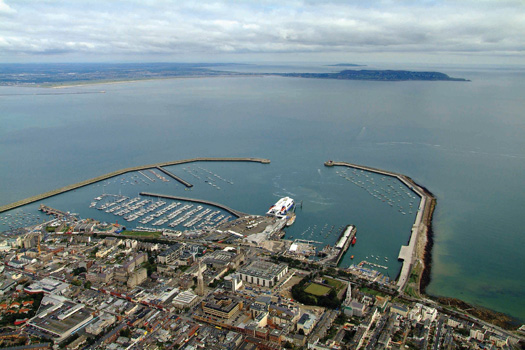
Kingpin harbour – Dun Laoghaire before the new "library" was erected at amazing speed in the middle of the waterfront. Photo courtesy ICC/Kevin Dwyer
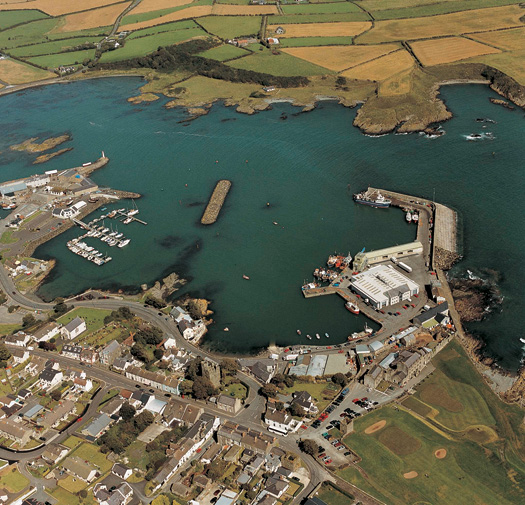
Ardglass. This little port has become one of the most useful of all, particularly for people who really do cruise. Photo courtesy ICC/Kevin Dwyer
It is just so conveniently located, you don't have to deviate at all from the direct course up and down Ireland's East Coast, and the welcome provided by marina manager Fred and his array of amiable animals is second to none. Quite how we managed before Ardglass marina was installed I don't know any more. But I think it involved far too many unnecessary nights at sea, whereas now you can have a convenient overnight in a quirky place where – if you're minded to eat ashore – you can ring the changes between one of the best Chinese restaurants on the coast, or else the golf club in the castle makes sailors more than welcome, and if you've had enough of the salty sea for a while, a very short taxi ride takes you into the utterly and very aromatically rural heart of the country and steaks at Curran's foodie pub.
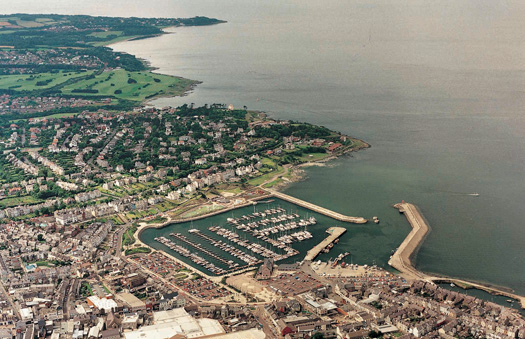
Bangor Bay's marina has settled in so well you could be forgiven for thinking the town was built around it. And you won't be surprised to learn that this part of North Down is known as the Gold Coast. Photo courtesy ICC/Kevin Dwyer
When these ICC Directions first appeared in book form in 1946, they covered only the east coast, and that only between Carnsore Point and the little harbour of Carnlough on the Antrim coast. In those days, there were few if any facilities for cruising boats beyond it on the Irish coast, so it was seen as the best jumping-off port for people headed for the more civilised cruising on Scotland's west coast.
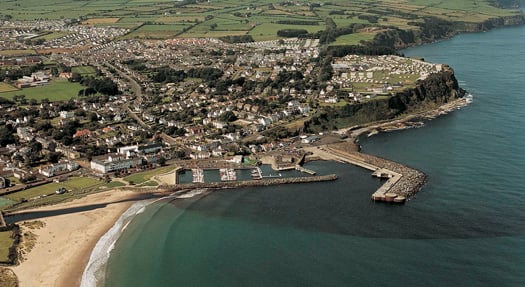
Ballycastle Harbour and marina required a king-size breakwater for full shelter, but its convenient location has been greatly beneficial for cruising the area. Photo courtesy ICC/Kevin Dwyer

Thirty years ago, the notion of Rathlin Island as a popular cruising destination would have seemed absurd, yet the provision of a harbour has brought about a welcome change, and in summer there are always at least several (and often many) cruising boats in port. Photo courtesy ICC.
So it's around Ireland's northeast corner that the changes have been most beneficial, with a proper harbour at Glenarm and –miracle of miracles – a real harbour at Ballycastle. It has had to be built as a really massive affair, for you're now on the rugged north coast, but it has opened things up to great benefit, as it's a short day sail from the Hebrides, the charms of Rathlin Island with its excellent little marina are just across the Sound, and with the pressure taken off to get to any old harbour with some short of shelter, you can explore the Antrim coast at your leisure. You come away convinced that the famous Carrick-a-Rede rope bridge looks even more spectacular when seen from sea, yet equally convinced by Dr Johnson's famous comment that while the Giant's Causeway may be worth seeing, it's not worth going to see.
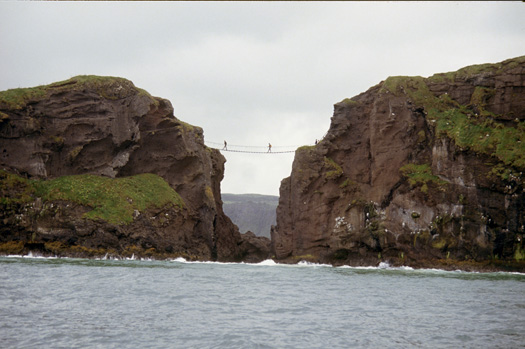
The north Antrim coast's famous Carrick-a-Rede rope bridge is best seen from a cruising boat. Photo: W M Nixon
Further along the north coast, there's excitement at Portrush as a 200 berth marina is planned for this key port. For anyone interested in harbour construction, it will be a fascinating project, for although Portrush is eastward of the most exposed point of all at Malin Head, it still manages to have truly ferocious sea conditions during winter storms. So the proposed new breakwater will have to be on mega-scale, but from a cruising point of view the provision of secure marina berths here will add an entirely new dimension. Portrush has direct rail connection with the rest of Ireland, and it provides the best departure port if you want to make a quick passage to the Outer Hebrides. A course from Portrush shaped to leave Skerryvore to starboard will take you neatly to Castlebay in Barra while leaving the inconvenient tides and turbulent waters of Islay well clear to the east, and the rough water north of Malin well away to the west.

Portrush as it is today. A plan for a 200 berth marina will necessitate an ambitious extension and reinforcement of the main breakwater. Photo courtesy ICC/Kevin Dwyer
But for anyone cruising on towards north Donegal, those demanding waters off Malin Head are part of the challenge, and plumb in the middle of them is storm-racked Inishtrahull. Amazingly, in the long distant past this little island supported several families, but these days its deserted state would make you wonder at the ICC book's assertion that there's quite a decent anchorage at Portmore on the island's hyper-rocky northern coast. So just to show that there is indeed an anchorage here, the book features a photo of Portmore with a fine cruising yacht serenely in the midst of it.
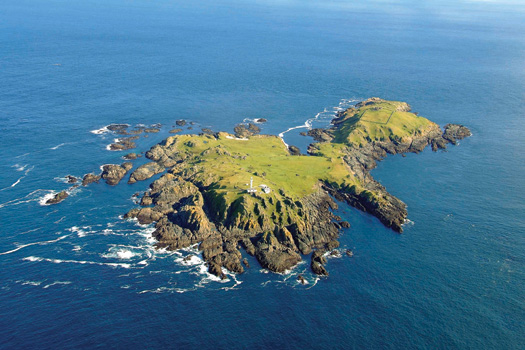
Remote Inishtrahull, most northerly part of Ireland. Yet there is an anchorage here..............
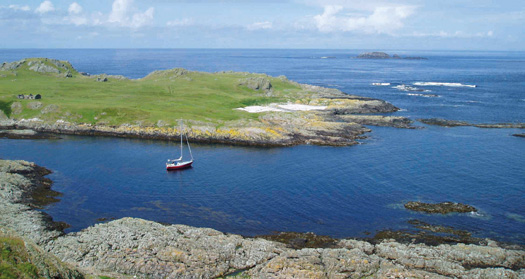
.....and the ICC book has the photo to prove it. Photos courtesy ICC/Kevin Dwyer/Ed Wheeler
West of Malin, the majestic north coast of Donegal includes the entrances to many inlets, the largest being Lough Swilly which is about the size of the Solent. The main sailing base is at the sandy creek at Fahan on the east shore where the provision of a marina brought expectations of proper well-planned shoreside supporting development to take the raw look off the place, but disappointingly it hasn't happened yet. We can only hope that the success of local sailor Sean McCarter as a skipper in the current Clipper Round the World Race will inspire the Fahan area to finish the job.
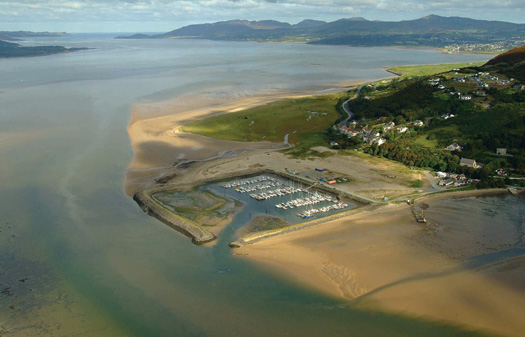
A job that really ought to be finished properly. The marina at Fahan on the east shore of Lough Swilly in Donegal is badly in need of appropriate shoreside development. Photo courtesy ICC/Kevin Dwyer
Further west, and its pure Atlantic, but relieved by remote and secure inlets. Nevertheless it's difficult to grasp that the secluded and forest-sheltered anchorage at lovely Ards on Sheephaven is only a very few miles from the storm-tossed rocks of Tory Island, but such is the case. At Camusmore on Tory, the tiny harbour seems to be hurricane-proof, for although it was in the most violently-assaulted of all areas on Ireland's west coast during the thirteen storms of the past rough winter, surprisingly Tory is not among the harbours listed for government largesse in the current tranche of funding for urgent repairs.
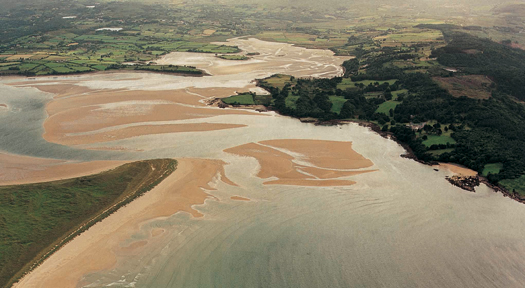
This snug tree-sheltered anchorage at Ards on Sheephaven does not accord with the popular perceptions of the rugged nature of North Donegal, yet here we see a lone cruising boat enjoying its gentle charms. Photo courtesy ICC/Kevin Dwyer
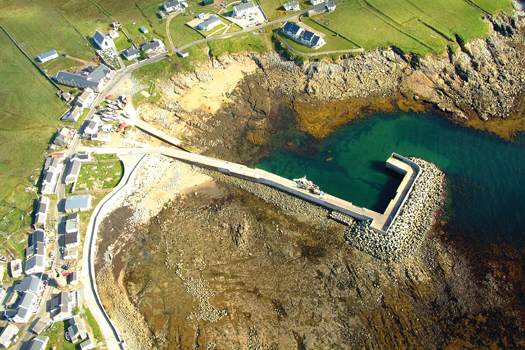
It's bullet-proof, it's hurricane proof – it seems there was no need for the little nugget of a harbour at Camusmore on Tory Island to apply for emergency funding for any urgent repairs despite the winter-long assault by at least thirteen different storms. Photo: Courtesy ICC/Kevin Dwyer
But Tory Island's nearest mainland quay at Magheraroarty is down for repair funding, and away to the far southeast at the crowded little harbour of Courtown in Wexford, they've a harbour which is down for more than €1 million in repairs expenditure. Courtown is a difficult one, a narrow little river port where life is a continuing struggle to keep the sand at bay, and yet stop the quay walls from being undermined. When you see what they had to do at Tory and Ballycastle to keep their harbours in place, you can't help but wonder if the sum allocated to Courtown is anything like enough, but at least official interest is being shown.
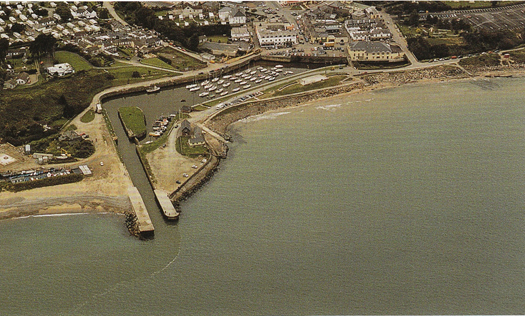
Courtown on Wexford's east coast is one of the harbours earmarked for urgent repair expenditure under this week's government scheme. Phot courtesy ICC/Kevin Dwyer
Many years ago, Paddy Barry set out to cruise round Ireland in his Galway Hooker St Patrick without using any anchorages recommended in the Sailing Directions by his fellow members of the ICC. It was just possible back then, and he overnighted at sixteen different places which were "unexplored". It would be virtually impossible to do that today, but even so it's entertaining to see if some favourite little places, some unknown quirky spots, have somehow slipped under the ICC radar.
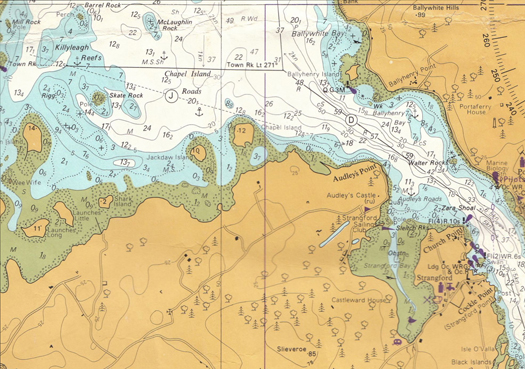
Has anyone overnighted there? The pool inside Chapel Island invites anchoring.
I can think of two, but have to admit that while I've seen them both, and seen boats in them, I've never taken a boat into either myself. One is a curious glaciated pool that is found behind Chapel Island in the southeast corner of Strangford Lough. At high water there's little enough shelter in the sound inside Chapel Island. But at low water, the classic Strangford Lough seabed emerges on either side, more than a metre high, while in the little pool you're lying in more than three metres. A couple of times I've seen a boat or two anchored in the area at high water while we've been hastening past entering or leaving the lough. But whether or not anyone has stayed on for the sweet entrapment at lower water I don't know, but would dearly like to hear from anyone who has.
The other secret place is one mile east of Rosslare ferry port. When the port was being almost completely redeveloped years ago, it seems they made this little harbour to accommodate all the local small boats which were being evicted from their long-established if often uncomfortable berths on the edges of the ferryport. It may well be that officially this harbour doesn't exist at all. As it is, there's a notice at it which states that the only people who are entitled to berth their boats there are persons normally resident in the electoral district of St Helen's, which is the area of Rosslare Ferryport. But for anyone cruising this tricky coast in a small boat, knowledge of the existence of this secret little harbour could even be a lifesaver when all other options have been closed off.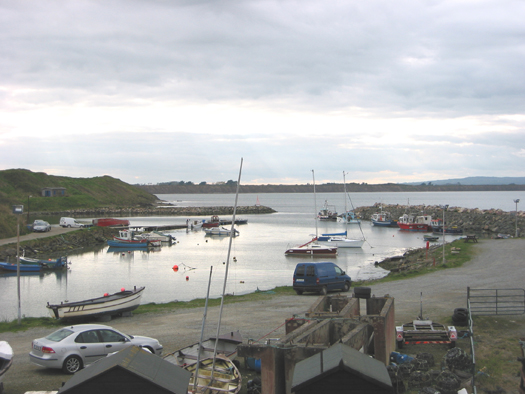
The secret little harbour one mile east of Rosslare doesn't claim to be a glamour spot, but it provides a very useful facility for local boat-owners. Photo: W M Nixon
It says everything about the completeness of the ICC books that these two little exceptions are the only unmentioned places I've been able to think of in the new East & North Coast book, and both are undoubtedly special cases. So once again Norman Kean and Geraldine Hennigan have created a masterpiece of it kind, a book which not only adds to safety when cruising our different regions, but greatly adds to the enjoyment of studying every aspect of our coastlines.
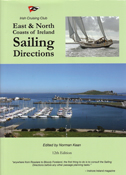
The latest and 12th Edition of the ICC's East & North Coast books continues a fine tradition of service to the cruising community which goes back to the first edition, a set of Roneo sheets produced in 1930. The new book is €37.50 (£29.95).
This blog was first published in March 2014.



























